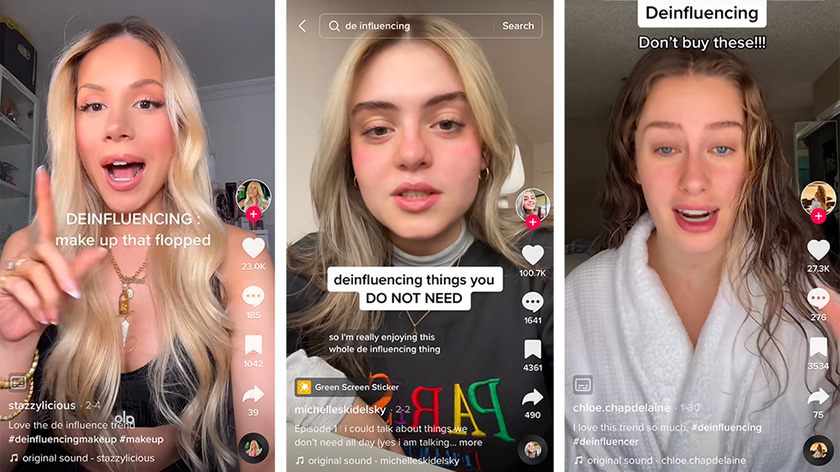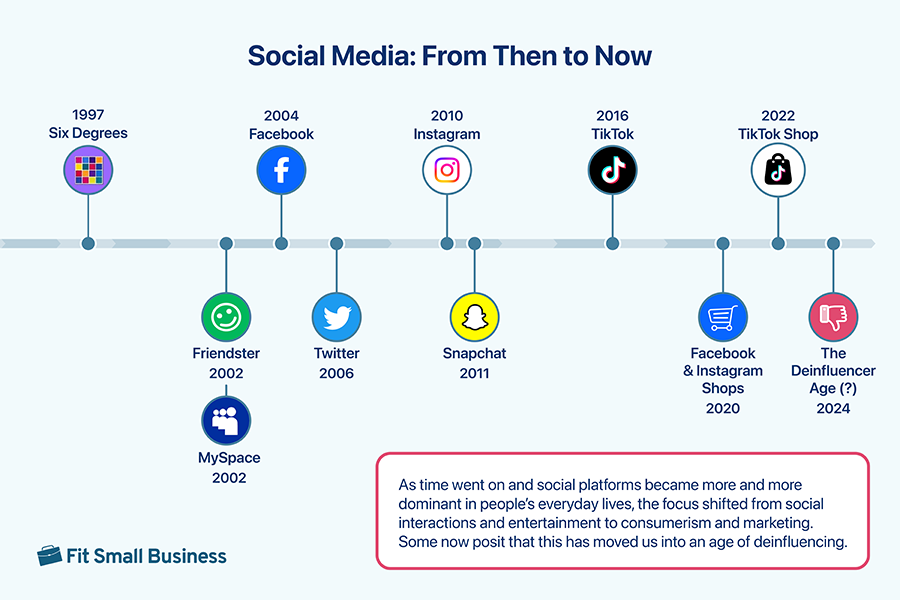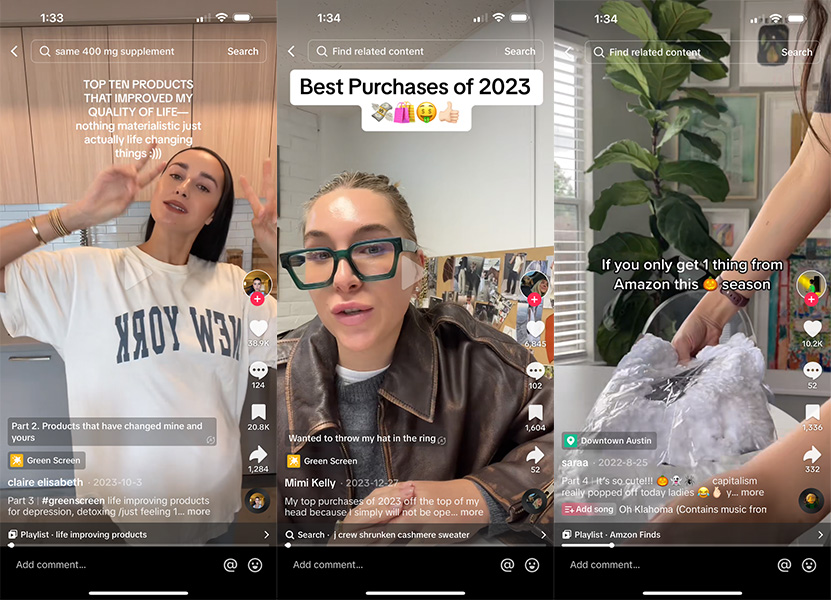We all know what influencers are—but in an age of consumer distrust, deinfluencers might hold even more sway.
What Is Deinfluencing? A New Age of Marketing Explained
This article is part of a larger series on Retail Management.
At the start of the New Year, my social media feeds took a turn toward anti-consumerism as established influencers and new creators alike began “deinfluencing” me. As you might have gleaned from the name of the phenomenon, deinfluencing is when online creators try to convince you not to purchase certain products, exposing why they don’t work, why they aren’t worth their price, and why you shouldn’t believe people who are trying to convince you otherwise.

Deinfluencing was introduced to social platforms at the start of the year as consumers were losing trust in traditional influencers and overconsumption was taking its toll. (Source: Fox Business)
In this article, we will explore exactly what inspired the deinfluencing trend, its impact on retail, and how you can adjust your marketing strategy to appeal to the “deinfluenced” shopper.
From Influencing to Deinfluencing: How Did We Get Here?

For the last several years, we have been in an age of influencer marketing. Our social media feeds have been filled with content created by influencers doing just what their title suggests—influencing. This can look like the promotion of healthier lifestyle choices, TV show recommendations, fitness motivation, outfit inspiration, and other intangible, non-commercial items. However, especially in recent years, influencers’ content has been largely centered around buying products.
When influencers first took over social media in the late 2010s , influencer product recommendations held a lot of water with consumers. The recommendations were perceived as genuine product endorsements, as opposed to traditional commercial ads. So, when these creators said that something was good, consumers tended to believe them, and, in many cases, bought the product. It’s no wonder that 90% of marketers found influencers to be effective back in 2021.
However, at some point, the tide changed—people began to doubt influencers and their authenticity. According to a recent study from Bulbshare, 84% of online consumers have lost faith in influencer recommendations. The general public had become more informed about how brand partnerships worked, they had seen too many cases where influencers were recommending products they didn’t actually like, and they had tried influencer-backed products that did not work.
And it was not only a lack of authenticity that was driving people away—it was also the relentlessness of the selling. There was seemingly something new every week and the pressure to constantly consume never ceased.
“Guys, this [insert product here] is life-changing”
“If you buy one thing, let it be [insert product here]”
“I have never tried a [insert product here] that worked so well.”
“[Insert product here] was the best purchase of the year, easily.”

Every day, there seemed to be some new product that was going viral, that influencers were backing, and that people needed to buy if they wanted to keep up. The stream of new, “life-changing” products was never-ending, and people were starting to lose interest and trust. In the face of this mistrust and the pressure to constantly consume, people began looking for something different. Cue, deinfluencing.
The Deinfluenced Consumer
With consumers demanding more authenticity, the age of the deinfluencer began. Where once people had scrolled only to see glowing product recommendations and beautifully curated influencer ads, they now got video after video of people telling them about how bad certain products were and why they should not buy them. There were certainly still influencer ads, but with deinfluencing coming on to social platforms, the pressure to overconsume was ebbing, authenticity was shining through, and new products weren’t being shoved in people’s faces at every scroll.
You could almost feel the collective sigh of relief as deinfluencing videos became the next big thing dominating social platforms, with the #deinfluencing hashtag garnering more than 1 billion views in just a few months on TikTok alone.

Deinfluencing offered consumers the breath of fresh air they needed, and while the trend faded, it left a lasting impression on how consumers understand marketing. (Source: The DiamondBack)
However, as with any social media trend, the deinfluencing movement ended almost as quickly as it started. The deinfluencing hashtag faded in use after about 10 months of traffic, and as of February, there are almost no deinfluencing videos being made. While you might assume that the disappearance of deinfluencing videos means that we returned to the previous status quo, this is not the case. The consumer has been forever impacted by the deinfluencing trend. It essentially validated their distrust, after all.
The deinfluenced consumer does not want to see “traditional” advertisements. They don’t want to see perfectly scripted influencer partnerships. They are not impressed by the marketing gimmicks of the past—they can see right through them. So, what will work? How can you adjust your marketing techniques to appeal to the new, deinfluenced consumer?
Marketing Strategies in an Age of Deinfluencing
The consumer is a different beast than it was before the age of deinfluencer marketing. They crave authenticity, transparency, and trust. Here are some strategies you can use to appeal to the deinfluenced consumer.
- Drop the script: In the past, brands would send products to influencers along with a script or set of points that the influencer would need to include in their content to receive payment from the brand. Modern consumers are all too aware of this dynamic and can sniff out a script easily, causing them to lose trust in what the influencer is saying. Avoid forcing scripts when working with influencers and rather take the no-strings-attached approach.
- No-strings-attached approach: Rather than a script, brands are now sending out their products to influencers with no strings attached. The idea is that if the influencer genuinely likes the product and wants to work with the brand again, they will recommend it organically and a more contractual relationship can be born from that organic place.
- User-generated content: As people’s trust in influencers and their reviews has faded, people have started to look for product information from people just like them. Reviews, demo videos, and other content from non-influencers, regular people are incredibly powerful for convincing people if a product is good or not. Promote UGC, good or bad, with rewards and include UCG on your product pages so people can find the information they want easily.
- Work with micro-influencers: Another way that you can continue to engage with influencers is by choosing micro-influencers. Micro-influencers typically have less than 15k followers and are not flooded with brand partnerships, so their content is typically more trustworthy among consumers.
- Work with product reviewers: Most industries—beauty, tech, toys, clothes, etc.—have influencers that operate as expert reviewers. Their entire brand is built off of making videos trying out and offering their expert opinions on products in their area of expertise. While it can be risky to send your products to reviewers, they are considered incredibly trustworthy sources for product information.
- Acknowledge your position: So many areas of our market are over-saturated, leading to both overconsumption and the paradox of choice for consumers. To create authenticity and connection with your customer base, you should acknowledge this in your advertising. From this acknowledgment of the consumers’ reality, you have the ability to explain how your product is different and why people need it.
- Focus on sustainability: Some demographics are tuned into the overproduction of goods and are actively trying to avoid overconsumption. If you can focus your brand and its messaging on sustainability, you will show customers that your goal is not to promote overconsumption and your product is a smart choice.
- Be transparent: To garner trust, show people how your product is made, the people behind your brand, how you got to where you are, how you set your pricing, and what your product is made of. This level of transparency is a great way to garner trust and build a relationship with distrustful consumers.
Frequently Asked Questions (FAQs)
Click through the questions below for the most common questions around deinfluencing.
Influencers are not losing their influence; if anything they are gaining power. However, their tactics are changing as people crave increased authenticity and a more conscientious content creator.
Yes. Deinfluencers can be a type of influencer (one focused on convincing people that certain products are bad), but more often, deinfluencing is a practice that influencers can—and should—incorporate as part of their regular content to maintain an air of authenticity.
You become a deinfluencer by making content in which your goal is to convince people not to buy certain products and then putting that content on a social platform.
Bottom Line
Deinfluencing arose because of an erosion of trust between traditional influencers and their followers, the constant pressure to consume, and the weight of a declining economy. While the volume of deinfluencing videos has declined as we move farther away from the New Year, deinfluencers left a lasting impact on consumers and how they understand product ads and influencer marketing.